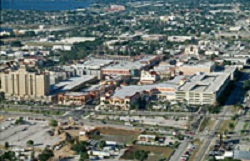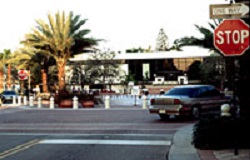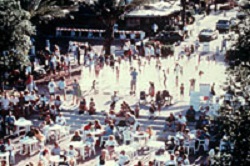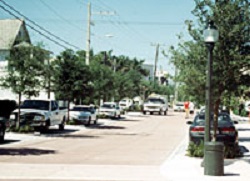Case Study No. 16
Street Redesign for Revitalization
West Palm Beach, Florida
Prepared by Natalie Rush, Transportation Planner, City
of Sarasota, FL, Laurie Actman, Patrick McMahon, and Henry Renski, University
of North Carolina Highway Safety Research Center. Information provided by Chuck
DeLeuw, City of Berkeley, CA and Mourad Bouaouina, University of California
at Berkeley.
Problem
The West Palm Beach, Florida, area was considered blighted and unpleasant for pedestrians.
Background

Aerial view of CityPlace along Okeechobee Boulevard.
By 1993, the downtown area of West Palm Beach was considered to be a quintessential blighted community. Roughly 80 percent of downtown property was vacant, crime rates were high, and the wide multi-lane one-way streets were designed so that drivers could move quickly through town without having to stop. At the time, the City was also $10 million in debt and had only $6,000 in capital reserves.
Solution
West Palm Beach wanted to rejuvenate its economy and community by redesigning downtown to accommodate and attract pedestrians. So, in 1993 Mayor Nancy Graham turned her focus to an ambitious downtown revitalization, including traffic calming measures to attract pedestrians.

Intersection of Clematis Street and Narcissus Avenue, eastern view.
In the heart of the downtown area, two legs of Clematis Street intersect with the North-South Narcissus Street forming a K-shaped intersection. The intersection was rebuilt as a raised intersection, emphasizing the pedestrian priority. Clematis Street was converted from a three-lane, one-way street with parking to a two-lane, two-way street with parking. Mid-block narrowings, intersection curb extensions/bulb-outs, a raised intersection and streetscaping reduced the physical and visual road width of Clematis Street, resulting in slower vehicle traffic, a shorter pedestrian crossing distance, wider sidewalks and a general softening of the street’s appearance. Narcissus Street was also narrowed from 30 to 20 ft and redesigned so that the entire street shifts twice laterally on every block. The narrow road and lateral shifts reduce drivers’ lines of sight and force vehicles to travel slower through the turns. Large palm trees were also incorporated into the design to create an optical narrowing that further reduced vehicle speeds.
Results

Interactive fountain at the Nancy M. Graham Centennial Plaza, eastern terminus of Clematis Street.
At the “K” intersection, the City built a pedestrian plaza, with a fountain at the center, and drastically modified the façade of the City’s library at the east end of the plaza. The fountain attracted adults and children who began returning to the downtown area and patronizing the nearby business. Business owners began renovating their facades through a government grant program. New businesses opened, and the area attracted more pedestrians as a shopping and cultural center developed. The City also started a weekly block party with music, food and craft vendors at the plaza, known as “Clematis by Night,” held every Thursday that brings approximately 3,000 to 5,000 visitors downtown every week.
Today, the area has an 80 percent commercial occupancy rate, and pedestrian activity has increased tremendously since the beginning of the revitalization effort. Property values, which once sold at $64 m2 ($6 ft2), rose to over $430 m2 ($40 ft2). The City is now planning to create a 24-hour downtown by encouraging new mixed use and residential development to enhance the pedestrian-orientation of the area.
Through the use of traffic calming and pedestrian amenities, West Palm Beach rebuilt its downtown into a safe, social and vital center for community activities. There are several successful projects that have already been completed and many more are either in the planning or construction phases of implementation.
The success of this project has opened the gates on a flood of new traffic calming projects around the City. The City and State are currently collaborating on a $55 million project to reconstruct U.S. Highway 1 through the City. The effort consists of eight sections that will include various traffic calming elements. In the downtown, the project will narrow a pair of three-lane one-way streets to two lanes and provide raised intersections at eight key pedestrian intersections.

Rosemary Avenue.
Slightly west of the Clematis Street and Narcissus Avenue area, the City purchased a 77 acre plot of land, which had been left vacant by a bankrupt developer in the 1970s. At the time, the property attracted the attention of $500 million worth of redevelopment and investment, known as “CityPlace,” that includes retail, residential, office, townhouses, a 20-screen theater, grocery store, and over 4,000 structured parking spaces. The project opened October 2000. Part of the redevelopment project includes the creation of pedestrian-friendly streets based upon traffic calming principles. The development has a Mediterranean theme and the sidewalk will be covered with arcades as outdoor places where pedestrians can stay dry during rainy days. The project also includes a public plaza in front of the refurbished historic church that sits in the heart of the project. Another key component of the effort includes the reconstruction of Rosemary Avenue to connect CityPlace to Clematis Street. Rosemary Avenue is the main street of CityPlace and Clematis Street is the historic main street of Downtown West Palm Beach.
In an effort to connect the two districts, the City reconstructed Rosemary Avenue to improve the pedestrian environment. The result is spectacular. The street has no curbs. The crown of the road is inverted and drainage runs to the center. The entire street was constructed with brick pavers. Street trees separate the parking stalls. All intersections are raised providing pedestrian priority. Many of the design elements were created due to the limited right-of-way and the location of existing buildings. The ultimate goal of the project was to increase the sidewalk widths and create an inviting pedestrian environment.
In an effort to connect the two districts, the City reconstructed Rosemary Avenue to improve the pedestrian environment. The result is spectacular. The street has no curbs. The crown of the road is inverted and drainage runs to the center. The entire street was constructed with brick pavers. Street trees separate the parking stalls. All intersections are raised providing pedestrian priority. Many of the design elements were created due to the limited right-of-way and the location of existing buildings. The ultimate goal of the project was to increase the sidewalk widths and create an inviting pedestrian environment.
Contact
Timothy Stillings, AICP
City Transportation Planner
City of West Palm Beach
200 2nd Street
P.O. Box 3366
West Palm Beach, Florida 33402
Phone: (561) 659-8031
Fax: (561) 653-2625
Email: tstillin@ci.west-palm-beach.fl.us





